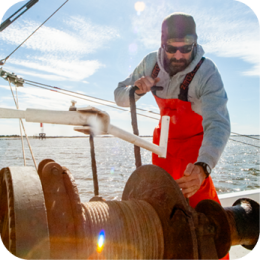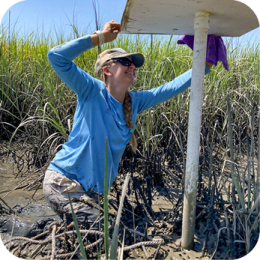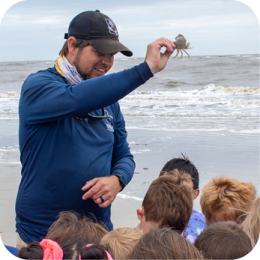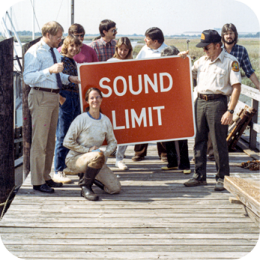The Coastal Non-point Source Program is a part of the Georgia Coastal Management Program that addresses water quality. It was mandated to all coastal states by Section 6217 of the Coastal Zone Act Reauthorization Amendment, and is administered at the federal level by the National Oceanic and Atmospheric Administration (NOAA). Thus, it is also referred to as the 6217 Program. It is a non-regulatory program that seeks to reduce non-point source pollution by providing funding, program development, and technical assistance for a range of activities that implement non-point source management measures, such as modifying existing construction design standards, local ordinances, public works and contractor training programs, and existing water quality protection programs. These management measures were mandated by the US EPA guidance document 840-B-92-002 (1993) and are non-numeric directives that seek to reduce non-point source pollution from sources that are exempt from regulation under federal or state environmental laws. That is, the 6217 management measures address pollution sources that were originally thought to be too insignificant to address by regulations. There are 56 of these measures.
Some examples of 6217 management measures that address urban and suburban activities are:
- Establish watershed protection programs that protect natural drainage systems and that preserve areas that provide important water quality benefits and or are necessary to maintain riparian and aquatic biota.
- Limit the increase of impermeable surfaces wherever practicable.
- Develop a watershed protection program that establishes/preserve streamside buffer zones.
- Include runoff management systems in the design of roads and bridges that reduce both volume of and pollutants.
Some examples of 6217 management measures that address marina operations include:
- Ensure that sewage pump-out facilities are maintained in operational condition and encourage their use.
- Provide and maintain adequate and appropriate storage and safe disposal of hazardous liquid material, solid waste (that are generated by customers), and encourage recycling of same.
The Coastal Non-point Source Program goal is to facilitate the development of any program that addresses the 6217 pollution management measures. Examples of qualifying programs include incentive programs to reduce pesticide use, educational programs aimed at the public and commercial sectors, flood control programs and initiatives, and stormwater Best Management Practice demonstration programs.
TMDLs and Non-point Source Pollution
TMDL stands for Total Maximum Daily Load. As part of the federal Clean Water Act, Georgia monitors representative waterways across the state for certain contaminants. In areas where these contaminants are found to persist, the Environmental Protection Division (EPD) develops a TMDL, which is the amount of a particular pollutant that the waterway under scrutiny can assimilate and still maintain its function as a fishable and/or recreational waterway. Many waterways across Georgia, and the nation, exceed their TMDLs for one or more pollutants. Thus, nearby local governments, industries, and other stakeholders within a particular watershed must come together and develop a plan for reducing their respective loadings of pollutants to the waterway. Most often in coastal Georgia, a TMDL has been developed for fecal coliform, a bacteria that is associated with and indicative of the presence of sewage/septage in the water way. There are also a few TMDLs for toxic metals. In the TMDL documentation developed by EPD for each waterway, two types of pollution entering the waterway are accounted for. One is the point-sources of pollution, meaning the wastewater discharges from industry and county/city domestic wastewater treatment plants. The other type is non-point source pollution, which is estimated by the types of land use in the watershed. For fecal coliform TMDLs, the non-point sources of pollution listed to be at fault are almost always septic systems and, in some areas, animal farms. Even a fairly small animal farm can contribute a great deal of sewage type bacteria to the nearby stream or ditch. To assist farmers in managing and minimizing pollutants originating from confined animal feeding operations, the University of Georgia Cooperative Extension created the Small Farm Nutrient Management Primer: For Un-permitted Animal Feeding Operations, which can be viewed by clicking on the following chapter links.
- Table of Contents
- Cover and Spines
- Best Management Practices Pull Out
- Chapter 1 Environmental Stewardship, Water Quality and Nutrient Balance
- Chapter 2 Farm and Homestead Maps
- Chapter 3 Manure Storage and Treatment Systems
- Chapter 4 Nutrient Budgeting with Nitrogen and Phosphorus
- Chapter 5 Land Application Procedures and Equipment
- Chapter 6 Maintaining Water Quality in Grazing Systems
- Chapter 7 Pesticide and Chemical Management for Water Quality
- Chapter 8 Mortality Management
- Chapter 9 Record Keeping
- Chapter 10 Coexisting with Neighbors
- Chapter 11 Emergency Action Plans
- Chapter 12 Resources for Small Animal Feeding Operation
Additional information on coastal water quality and non-point source pollution monitoring may be obtained by clicking on one of the following links:







